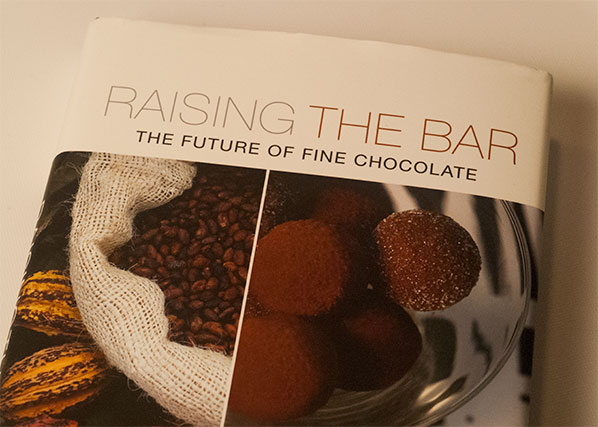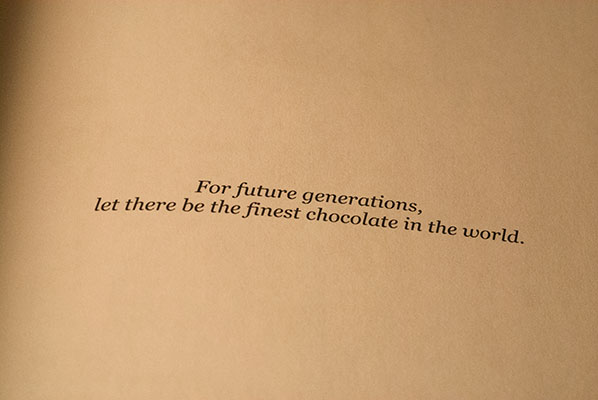A couple of weeks ago, I was privileged to be at the launch of Pam William’s new book, Raising the Bar: The Future of Fine Chocolate.
Co-written with Jim Eber, Pam’s hot off the presses book is a highly informative and interesting examination of what the future may hold for fine chocolate and those who are attempting to preserve its unique and diverse flavours.
As Pam sees it a bit of a crisis is happening out there in the world of fine flavor cacao.
There isn’t much of it out there, to begin with. There are lots of people who want it, but currently, the farmers are not benefiting from that: they are not getting more money, being paid a premium for growing a great tasting product, and Pam would like consumers to support the farmers getting a better price for their product.
As she says:
“We’ve gotten our tomato back. For years, tomatoes tasted good, then we had tomatoes that tasted like cardboard, and after a long while the consumer complained, and we started seeing first hot-house, and then heirloom tomatoes making their way back into the market. I don’t want us to lose our fine flavor chocolate, to have it go the same way as tomatoes did. We need to preserve what makes these fine flavours unique and diverse.”
The book launch was held in the inviting atmosphere of Barbara Jo’s Books to Cooks, in Vancouver. We were invited in to sip a glass of wine, sample some very nice chocolate, and listen to Pam, an engaging and funny speaker, who invited many questions from the eager group of chocolate lovers.
Before signing our copies of the book, Pam led us through a discussion of the four major pillars in the production of chocolate: the genetics of the tree to produce the pods, the farmer who handles and takes care of the trees, the manufacturer who turns the cacao into chocolate, and finally, the chocolatier who makes it into bonbons and confections, what Pam calls “value added” products.
She began by giving us a brief history of chocolate marketing.
Until 20 years ago, most commercial chocolate was blended for consistency of product, so that each chocolatier would know that the outcome of their confections would produce consistent results, every time – important if you are making your livelihood selling a product that people have come to recognize and appreciate for tasting a particular way – a consistent flavor profile.
Then, about 20 years ago, the French chocolate manufacturer, Valrhona, had some beans from different farms in Madagascar which they wanted to use just the way they were, because they tasted very good. What they came up with was a chocolate called Manjari. It is a 64% dark chocolate, with the flavor notes (from the Valrhona website) of: Fresh & Acidulous Pure Madagascar. Fresh, acidic, sharp bouquet with red fruit notes. Single Origin Chocolate.
It was the first chocolate to have a specific flavor profile based on country of origin.
Pam passed around sample for us to try, and it is indeed (in my opinion) a lovely, smooth, flavourful dark chocolate, with what Pam calls a “French” mouth-feel: slightly more cocoa butter than is naturally occurring … to make a richer taste.
This is what she and the people she interviews for her book are hoping to preserve.
She tells us that 95% of the world’s chocolate is mass-produced for the big guys like Cadbury’s, Hershey, and Mars. Mass-produced chocolate is all blended, once again, for consistency of flavor.
Fine flavor cacao makes up only 5%, of the world’s chocolate.
Pam encourages that just like wine tasting, different flavours will appeal to different people.
“You have to taste a lot of chocolate to find out what you like. It’s a dirty job, but somebody has to do it. You’ve got to get that chocolate in your mouth….An ounce or two of great tasting dark chocolate will make you a better person – just a bit – don’t go overboard.”
Pam also discussed of the sometimes murky waters and confusing labeling of what is known as Fair Trade and Organic chocolate.
“Fair Trade worries me a little,” Pam says.
To quote Raising the Bar:
‘Today, almost everyone in the world of fine flavor chocolate, and even many in the chocolate business in general, talk about how fidelity to farmers is essential to the industry’s preservation. They may disagree on solutions and diverge in their business models and approaches, but they all agree on the importance of direct relationships, fair prices, social responsibility and better processing at origin.’
She clarifies,
“To become certified is very expensive. To a great extent, the people who are making money in Fair Trade, especially in the cacao industry are the organizations themselves rather than the farmer.
95% of cacao is grown on small family farms. Fine flavor cacao is grown mainly in Central and South America and Madagascar. Most of the people who grow fine flavor cacao have a hectare or two or three to farm. They cannot afford certification on their own, so they form co-operatives which become certified.
There are often many middle men on that path from the farmer to the certification organization, and the concern is that the extra money coming in isn’t going back to the farmer.
We would rather see the principals of the Direct Cacao Movement being applied, where the manufacturer is buying directly from the farmer with no middle men.
At present, farmers bring their beans to the broker at a collection centre and are paid by them. The collection centre guy doesn’t care about the quality of the beans – they all go into the same pile, and the farmer is obliged to take the price that is offered.
We would rather see the farmers being paid more to grow the better tasting beans. We would like to see that the farmer gets paid a premium if they are growing premium beans. Once the farmer knows what type of cacao he has, he can start demanding a better price.
Which is not to say certification is not a good thing – it is – especially in Africa, where there are huge problems with slavery and mistreatment of workers, but it is not a one size fits all solution.”
And indeed, the second section of the book, and indeed its longest part, features an in-depth examination of the differing initiatives and business models people are employing to provide better working conditions and self-sufficiency for the farmer.
Pam spoke briefly about the Heirloom Cacao Preservation Initiative, a project about which she is passionate:
The Heirloom Cacao Preservation Initiative, a partnership between the Fine Chocolate Industry Association (FCIA) and the USDA’s Agricultural Research Service (USDA-ARS) to create the first-ever genotype map with a focus on flavor cacao trees.
The Heirloom Cacao Preservation Initiative (HCP) will connect everyone with a stake in the future of fine flavor chocolate to a very specific set of goals:
- To know where the world’s finest flavor beans are;
- To tie their flavor to the genetics; and ultimately
- To help ensure cacao quality and diversity, and preserve and propagate fine flavor beans for future generations.
Pam asks us to think of chocolate, not as a commodity, but as an agricultural product that needs to be nurtured.
She asks us to think of it as a fresh food, like the heirloom tomatoes we value so much for their unique taste.
Raising the Bar is a book for chocolate lovers. It’s for chocolate aficionados who want to hear more about what is really happening in the world of chocolate, right from the ground up.
It’s available in a hard cover or ebook version, details at the EcoleChocolat website. (If you’re in Vancouver, you might still find some signed copies at Barbara Jo’s Books to Cooks)
And here’s a short video with Pam at the book launch:



